Finally got this Knox 602 widowmaker restore wrapped up (at least for now). Borrowing ideas from schematics from other amps with this same tube set, I found:
Some of the changes recommended on this thread sounded good when added to the circuit with clips, but were too physically difficult in this point-to-point rat's nest to bother making permanent.
Here's the final schematic (oops, missing an indication that input jack sleeves are grounded, but they are):
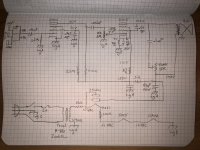
And some gut shots:
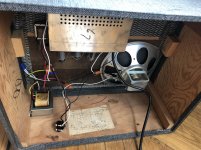
Isolation transformer and 3-prong power cord installed. The jack hanging off of wires here mounts on the back panel, and connects the OT to speaker when nothing is plugged in. When connected, it disconnects the OT leads and connects the speaker cable to the speaker instead. This is so I can use the cabinet as a 1x8 for other amps — part of the reason I bought this thing.
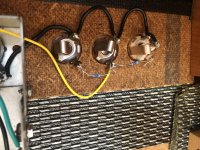
New input jack wiring, with a grounding disconnect jack on the right.
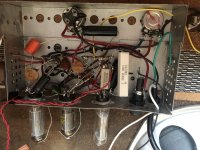
The rat's nest.
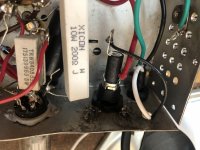
The hole for the old capacitor can was a perfect place to add a fuse.
Finally, here's a video in which I run through some of the sounds I've been able to get with my Tele:
YouTube
Thanks for all your help!
- Increasing the cap on the 12AU6 screen from 1nF to 47nF greatly improved bass / low mid response and sounded good to my ears.
- Adding a 220pF bright cap across the volume pot made things less congested, and at times even bright enough with single coils to make the existing tone control seem actually useful.
Some of the changes recommended on this thread sounded good when added to the circuit with clips, but were too physically difficult in this point-to-point rat's nest to bother making permanent.
Here's the final schematic (oops, missing an indication that input jack sleeves are grounded, but they are):

And some gut shots:

Isolation transformer and 3-prong power cord installed. The jack hanging off of wires here mounts on the back panel, and connects the OT to speaker when nothing is plugged in. When connected, it disconnects the OT leads and connects the speaker cable to the speaker instead. This is so I can use the cabinet as a 1x8 for other amps — part of the reason I bought this thing.

New input jack wiring, with a grounding disconnect jack on the right.

The rat's nest.

The hole for the old capacitor can was a perfect place to add a fuse.
Finally, here's a video in which I run through some of the sounds I've been able to get with my Tele:
YouTube
Thanks for all your help!
Last edited:
Screen cap in "good" amps could be 0.1u to 0.5u. 1nF (0.001u) was awful cheezy. 47nF may be good for guitar. At the low currents here, it may be full-bass.
The 110V leads running through a hole in the chassis scare the pants off me. Given enough time the insulation WILL chafe-through and either electrocute the user or burn-up the power cord. They could even cut-through if the amp falls off the bench while the cord is snagged on something. IMHO you should fix that before anything bad happens. (Unless you are very sure the hole edges are rounded and met UL's yank-test; even then the test may have changed since 1959 in light of bad experience with unbushed holes.)
The 110V leads running through a hole in the chassis scare the pants off me. Given enough time the insulation WILL chafe-through and either electrocute the user or burn-up the power cord. They could even cut-through if the amp falls off the bench while the cord is snagged on something. IMHO you should fix that before anything bad happens. (Unless you are very sure the hole edges are rounded and met UL's yank-test; even then the test may have changed since 1959 in light of bad experience with unbushed holes.)
Thanks for the warning on the high voltage leads running through chassis holes. The original setup had some of this kind of thing happening, so I'd decided not to worry about it. But I'll take your advice when it comes to safety. Maybe I can find a grommet that will fit...
- Status
- This old topic is closed. If you want to reopen this topic, contact a moderator using the "Report Post" button.